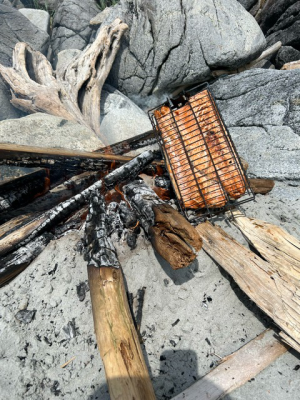Sharphooks
Well-Known Member
After all the years I’ve spent in these waters, I can usually tell how the fishing part of the trip is going to go by the relative fishing success of the first few days. Big success early in the trip sometimes foreshadows crappy catching for the remainder. Over the years I’ve learned to temper my expectations. But as most guys who have spent any amount of time on the water this spring and summer already know, the 2023 chinook fishery has been phenomenal. It started that way for me this trip and didn’t miss a beat for 30 days straight. It was almost too much to bear, especially with a very strong coho return going on at the same time.
Hakai has always been stingy to me for springs. I’m thrilled if I get 1 or two in a trip. This year I caught more springs in two days at Hakai then I’ve caught there in the last 7 years. And the first one was pushing Tyee. I wasn’t doing anything any different then I normally do. There were just way more fish around.
On my first day at Hakai I was trying to catch a coho in the middle of Fitzhugh CHannel to barbecue on West Beach at Pruth Bay. I was in 600 feet of water fishing my bait at 50 feet. A huge violent take down. I knew right away this wasn’t a coho. This fish was my first warning that this year wasn’t going to be like all the others.
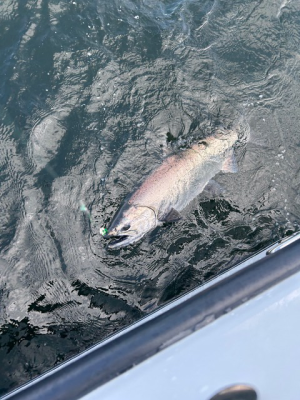
The first couple of weeks of the trip I had phenomenal weather—-flat calm seas....zero wind. I’ve already learned that when you get weather like that, make the outside move immediately because you might not get a second chance. I was heading north for the Nepean Sea.
This screen cap from the TM265HW transom mount I installed this year shows the drill that produced lots of chinook for the trip:
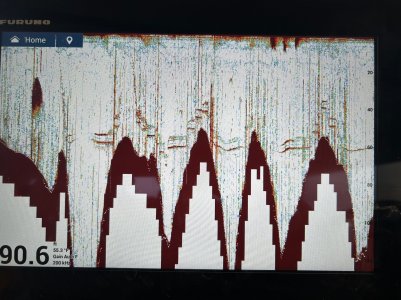
And this was the magic formula: A 10 pound ball, a dummy flasher, and a small fluttering spoon like a coho killer or a Skinny G pinned to a release line that had several willow blades on them to make it look like a small school of bait fish when underway.
And the direct connection of spoon to mainline without a stinking flasher in the way made for a quick efficient way to shake off all those fish using a gaff.
Nets have ZERO place in a catch and release fishery (which I always practice for the first 98% of the trip) and I’m amazed to see the amount of guys out there who still have not gotten this message.
Guys—please ditch the nets if you’re turning the fish loose —And use a gaff to shake them!!!
A stout leader and a glove on the left hand to hold that leader, and a gaff in the right hand…production fishing with minimal blood and fuss
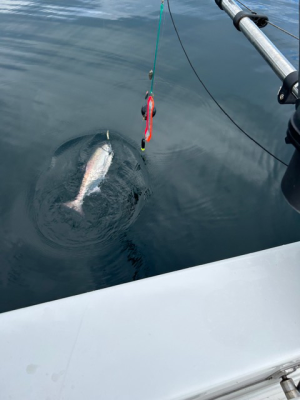
A word about the 10 pound ball. I remember a few years ago reading a guide’s comment about ball weights. When fishing downriggers he said, one should be able to fish any condition with no more then a 10 or 12 pound ball. I decided to put that to the test this trip. With the exception of winter springs stuck to the bottom in 200 feet of water in a strong tidal situation where maybe a 15 pound ball might pay off, I became a believer in the lighter is better approach on this trip.
This is the first trip I’ve ever taken where I used one ball the entire trip and came back to my dock not only with the same ball but with ALL the same gear I left with. I could sneak that ball into the tightest of hidey holes and with the help of multiple transducers to confirm situational awareness between rocks, gear and boat, and having a Scotty 2106 HP with its lightening fast retrieve, I could always bring that ball back to the boat. The only downside was the 10 pound ball was not heavy enough to pull the braid off the Scotty on its own despite adjusting the tension nut—I finally resorted to getting it to pay out line with a couple of pulls on the braid and spinning the downrigger spool with my thumb.
By this time I was starving for a barbecued fish and waited patiently to get a spring that would be small enough to consume in a couple of meals with the dog’s help. I finally got an 8 pound fish and went in to one of my favorite beaches and got a rip-roarer fire going
Ya, looks like it was still alive and flopping on that log —-it fooled the dog. But it was just a simple case of rigor mortis from being carried to shore in a bucket... also known as Rigger Mortem
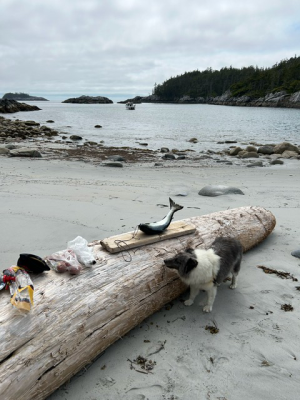
Have I mentioned the stunning cooking results I’ve learned to expect with the new grill I purchased? I used to think it was normal to lose 1/3 of my fish to getting charred or over-cooked or polluted with sand during the cooking process. No more. I can now cook every fish to perfection without losing even a sliver
Build yourself a cowboy fire using way more wood then you would usually use, prop the grill up on a log with a stabilizing stick to keep it at a slant and let the flames and coals get the job done. The grill locks the fillets in place. The bigger the fire, the farther away from the flames you set up the grill. Once they’re cooked you open up the package, eat your dinner, then close it back up and stick it in a bag for the ride back to the mothership to eat the next day for lunch.
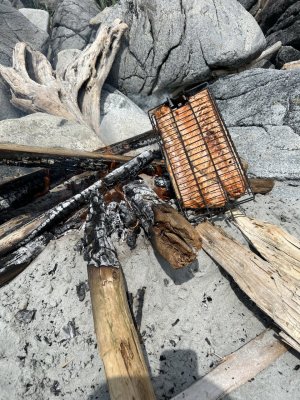
Finishing off the spring while looking for another....
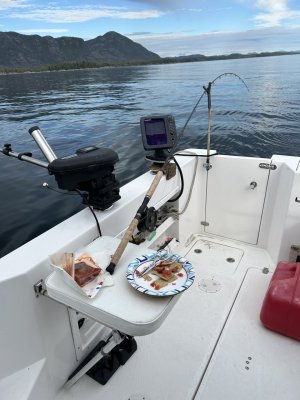
This was the evening the dog and I got to enjoy while sitting on the beach eating that fish:

Hakai has always been stingy to me for springs. I’m thrilled if I get 1 or two in a trip. This year I caught more springs in two days at Hakai then I’ve caught there in the last 7 years. And the first one was pushing Tyee. I wasn’t doing anything any different then I normally do. There were just way more fish around.
On my first day at Hakai I was trying to catch a coho in the middle of Fitzhugh CHannel to barbecue on West Beach at Pruth Bay. I was in 600 feet of water fishing my bait at 50 feet. A huge violent take down. I knew right away this wasn’t a coho. This fish was my first warning that this year wasn’t going to be like all the others.

The first couple of weeks of the trip I had phenomenal weather—-flat calm seas....zero wind. I’ve already learned that when you get weather like that, make the outside move immediately because you might not get a second chance. I was heading north for the Nepean Sea.
This screen cap from the TM265HW transom mount I installed this year shows the drill that produced lots of chinook for the trip:

And this was the magic formula: A 10 pound ball, a dummy flasher, and a small fluttering spoon like a coho killer or a Skinny G pinned to a release line that had several willow blades on them to make it look like a small school of bait fish when underway.
And the direct connection of spoon to mainline without a stinking flasher in the way made for a quick efficient way to shake off all those fish using a gaff.
Nets have ZERO place in a catch and release fishery (which I always practice for the first 98% of the trip) and I’m amazed to see the amount of guys out there who still have not gotten this message.
Guys—please ditch the nets if you’re turning the fish loose —And use a gaff to shake them!!!
A stout leader and a glove on the left hand to hold that leader, and a gaff in the right hand…production fishing with minimal blood and fuss

A word about the 10 pound ball. I remember a few years ago reading a guide’s comment about ball weights. When fishing downriggers he said, one should be able to fish any condition with no more then a 10 or 12 pound ball. I decided to put that to the test this trip. With the exception of winter springs stuck to the bottom in 200 feet of water in a strong tidal situation where maybe a 15 pound ball might pay off, I became a believer in the lighter is better approach on this trip.
This is the first trip I’ve ever taken where I used one ball the entire trip and came back to my dock not only with the same ball but with ALL the same gear I left with. I could sneak that ball into the tightest of hidey holes and with the help of multiple transducers to confirm situational awareness between rocks, gear and boat, and having a Scotty 2106 HP with its lightening fast retrieve, I could always bring that ball back to the boat. The only downside was the 10 pound ball was not heavy enough to pull the braid off the Scotty on its own despite adjusting the tension nut—I finally resorted to getting it to pay out line with a couple of pulls on the braid and spinning the downrigger spool with my thumb.
By this time I was starving for a barbecued fish and waited patiently to get a spring that would be small enough to consume in a couple of meals with the dog’s help. I finally got an 8 pound fish and went in to one of my favorite beaches and got a rip-roarer fire going
Ya, looks like it was still alive and flopping on that log —-it fooled the dog. But it was just a simple case of rigor mortis from being carried to shore in a bucket... also known as Rigger Mortem

Have I mentioned the stunning cooking results I’ve learned to expect with the new grill I purchased? I used to think it was normal to lose 1/3 of my fish to getting charred or over-cooked or polluted with sand during the cooking process. No more. I can now cook every fish to perfection without losing even a sliver
Build yourself a cowboy fire using way more wood then you would usually use, prop the grill up on a log with a stabilizing stick to keep it at a slant and let the flames and coals get the job done. The grill locks the fillets in place. The bigger the fire, the farther away from the flames you set up the grill. Once they’re cooked you open up the package, eat your dinner, then close it back up and stick it in a bag for the ride back to the mothership to eat the next day for lunch.

Finishing off the spring while looking for another....

This was the evening the dog and I got to enjoy while sitting on the beach eating that fish:

Attachments
Last edited:


